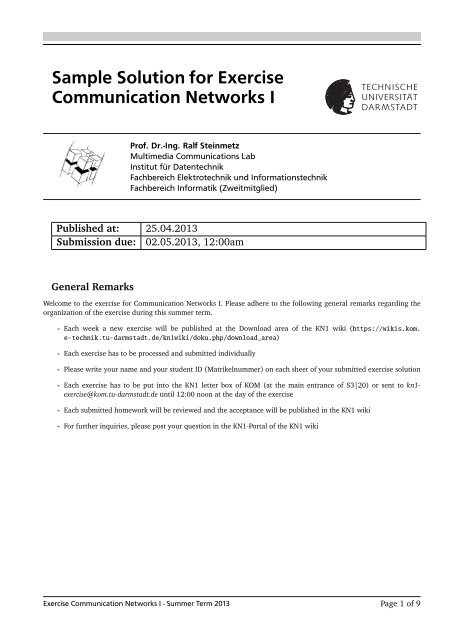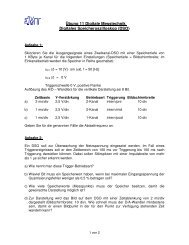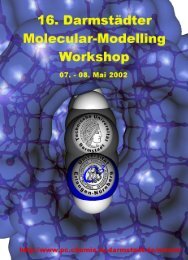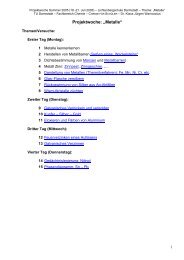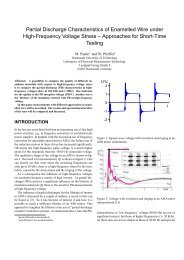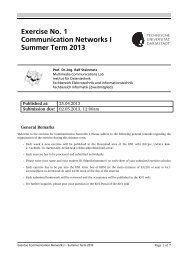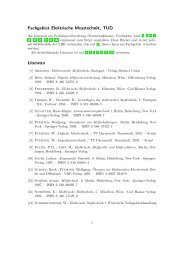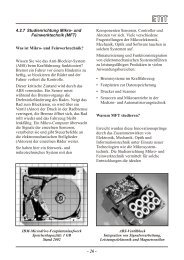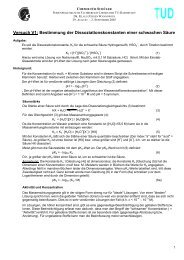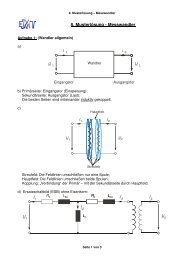Sample Solution for Exercise Communication Networks I
Sample Solution for Exercise Communication Networks I
Sample Solution for Exercise Communication Networks I
- No tags were found...
Create successful ePaper yourself
Turn your PDF publications into a flip-book with our unique Google optimized e-Paper software.
<strong>Sample</strong> <strong>Solution</strong> <strong>for</strong> <strong>Exercise</strong><strong>Communication</strong> <strong>Networks</strong> IProf. Dr.-Ing. Ralf SteinmetzMultimedia <strong>Communication</strong>s LabInstitut für DatentechnikFachbereich Elektrotechnik und In<strong>for</strong>mationstechnikFachbereich In<strong>for</strong>matik (Zweitmitglied)Published at: 25.04.2013Submission due: 02.05.2013, 12:00amGeneral RemarksWelcome to the exercise <strong>for</strong> <strong>Communication</strong> <strong>Networks</strong> I. Please adhere to the following general remarks regarding theorganization of the exercise during this summer term.- Each week a new exercise will be published at the Download area of the KN1 wiki (https://wikis.kom.e-technik.tu-darmstadt.de/kn1wiki/doku.php/download_area)- Each exercise has to be processed and submitted individually- Please write your name and your student ID (Matrikelnummer) on each sheet of your submitted exercise solution- Each exercise has to be put into the KN1 letter box of KOM (at the main entrance of S3|20) or sent to kn1-exercise@kom.tu-darmstadt.de until 12:00 noon at the day of the exercise- Each submitted homework will be reviewed and the acceptance will be published in the KN1 wiki- For further inquiries, please post your question in the KN1-Portal of the KN1 wiki<strong>Exercise</strong> <strong>Communication</strong> <strong>Networks</strong> I - Summer Term 2013 Page 1 of 9
Problem 1 - Multiple Choicea) Why does the Data Link Layer append a trailer to frames?A) This is due to the router configuration.B) The Data Link Layer runs always in reverse mode.C) Defined by IP.D) The Data Link Layer only appends a header, but never a trailer.E) This way the checksum <strong>for</strong> error correction can be done “on the fly”.<strong>Solution</strong>: Answer Eb) Which layer does IP belong to?A) Physical LayerB) Data Link LayerC) Network LayerD) Transport LayerE) Application Layer<strong>Solution</strong>: Answer Cc) Which is not a layer in the ISO-OSI model?A) Security LayerB) Physical LayerC) Data Link LayerD) Network LayerE) Transport Layer<strong>Solution</strong>: Answer Ad) Which of the following statements is true?I) In a well designed system, the higher layer does not have to worry about the implementation details of lowerlayersII) A layer offers a service to the next higher layerIII) Two entities of the same layer handle a protocolSelect the correct option:A) Only IB) I and IIC) I, II and IIID) Only IIE) II and III<strong>Solution</strong>: Answer Ce) Which of these encoding mechanisms are not “self-clocking”?I) Manchester encodingII) Differential Manchester encodingIII) Binary encodingIV) Nonreturn to zero<strong>Exercise</strong> <strong>Communication</strong> <strong>Networks</strong> I - Summer Term 2013 Page 2 of 9
V) Return to zeroSelect the correct option:A) I, II and IIIB) I, II and VC) II, IV and VD) III and IVE) IV and V<strong>Solution</strong>: Answer Df) What is the technique of merging inputs of many links onto one link called?A) DigitalizingB) MultiplexingC) TransmittingD) TunnelingE) Routing<strong>Solution</strong>: Answer B<strong>Exercise</strong> <strong>Communication</strong> <strong>Networks</strong> I - Summer Term 2013 Page 3 of 9
Problem 2 - Terminologya) Name objectives of communication networks with examples.<strong>Solution</strong>: Shared usage of resources- programs- data- devicesAllows <strong>for</strong>/to- enhance reliability- load balancing- cost reduction, e.g. shared usage of a data server- easier extensibilityHigh-per<strong>for</strong>mance communication media- person to person (e.g. E-mail, interactively)- person to machine (e.g. data bases, WWW, video server)- machine to machine (e.g. often Peer-to-Peer)b) Explain the terms service and protocol in the context of the layer model.<strong>Solution</strong>: The instance of a layer provides a service which is used from the layer above. Two instances of the same layerhandle a protocol.c) Explain the terms connection-oriented service and connectionless service with examples.<strong>Solution</strong>: A connection oriented service consists of three phases:1) connect2) data transfer3) disconnectExample: TelephoneA connectionless service, each message carries the full destination address and is routed through the system independently.Example: Postal systemd) Consider the following illustration of a packet. What do you notice?H4 H3 H5 DataH: Header-Data<strong>Solution</strong>:It is unusual that the header data of a layer is stored behind the header data of the layer above. However, it is possiblethat protocol data is attached at the end of the data packet (Calculation “on the fly”)<strong>Exercise</strong> <strong>Communication</strong> <strong>Networks</strong> I - Summer Term 2013 Page 4 of 9
e) Characterize a communication network in demarcation to- Master/Slave configuration- Multiprocessor system- Distributed system<strong>Solution</strong>:Master/Slave configuration → CN: keyword autonomous systemMultiprocessor system → CN: keyword spatial extentionDistributed system → CN: keyword distribution transparencyf) The president of a company designing cellular phones wants to start a joint venture with a company designingmicrochips. He tells his legal department to look into it who in turn asks engineering <strong>for</strong> help. As a result, thechief engineer calls his counterpart of the other company to discuss the technical details of the project. Theengineers then report back to the legal department, which then confer by telephone to arrange the legalaspects. Finally, the two presidents discuss the finances of the deal. Is this an example of a multilayer protocolin the sense of the OSI model?<strong>Solution</strong>: No, in the ISO model, physical communication only takes place in the lowest layer, not in every layer.g) A system has a n-layer protocol hierachy. Applications generate messages of length M bytes. What fraction ofthe network bandwidth is filled with headers, if at each of the layers a h-byte header is added?<strong>Solution</strong>: The total number of header bytes per message is hn, there<strong>for</strong>e, the fraction is hn/(hn + M)h) What is the Interplanetary Internet Special Interest Group?<strong>Solution</strong>: The objective of the Interplanetary Internet project is to define the architecture and protocols necessary topermit interoperation of the Internet resident on Earth with other remotely located internets resident on other planets orspacecraft in transit.<strong>Exercise</strong> <strong>Communication</strong> <strong>Networks</strong> I - Summer Term 2013 Page 5 of 9
Problem 3 - Layer Modela) Describe the Layers of the ISO-OSI Model and their function.<strong>Solution</strong>:LayerFunction1 sending bit 1 is also received as bit 1Physical (and not as bit 0):2 reliable data transfer between adjacent stations with framesData Link3 connection endsystem to endsystemNetwork4 connection end/source (application/process) to end/destinationTransport(application/process)5 support a “session” over a longer periodSession6 data presentation independent from the end systemPresentation7 application related servicesApplicationb) What are the differences of the ISO-OSI Model to the TCP/IP Model?<strong>Solution</strong>: ISO - OSI:- “A first step towards international standardization of protocols”- devised be<strong>for</strong>e protocols were inventedTCP/IP:- developed with the ARPANET, connect multiple networks- main idea: robust network (connectionless internetwork layer)(→ Tanenbaum)<strong>Exercise</strong> <strong>Communication</strong> <strong>Networks</strong> I - Summer Term 2013 Page 6 of 9
Problem 4 - TopologyIn topology I), 7 routers are interconnected by a binary tree. In topology II) they are interconnected in a ring, and intopology III) there is link between any two routers.12172172 336364 5 6 7I4 5II4 5IIIa) A message is sent via the shortest path. For each topology, what is the average number of hops, assumingthat all router pairs are equally likely? The router-host and router-router links are counted as one hop each.<strong>Solution</strong>:Total number router pairs: 6 + 5 + 4 + 3 + 2 + 1 = 21I/II/III 2 3 4 5 6 71 1/1/1 1/2/1 2/3/1 2/3/1 2/2/1 2/1/12 2/1/1 1/2/1 1/3/1 3/3/1 3/2/13 3/1/1 3/2/1 1/3/1 1/3/14 2/1/1 4/2/1 4/3/15 4/1/1 4/2/16 2/1/1I) cumulated # hops: 48 → n I = 48/21 = 2, 3II) cumulated # hops: 42 → n I I = 42/21 = 2III) 1b) The probability <strong>for</strong> a router being down is p. What is the probability that the path from router 4 to router 7exists, assuming that neither 4 nor 7 are down.<strong>Solution</strong>: Probabiliy <strong>for</strong> a router being up: (1 − p)I) P I = (1 − p) 3II) P I I = 1 − (1 − (1 − p) 2 )(1 − (1 − p) 3 )III) 1c) Discuss the advantages and disadvantages of each topology.<strong>Solution</strong>: Topology I) is very cheap to build. However, due to lack of redundancy, the failure of a router can causeproblems.Topology III) is the most expensive and highly redundant. Two routers can still communicate even if all others are down.Topology II) is somewhere in between. Some redundancy; not cost optimal.<strong>Exercise</strong> <strong>Communication</strong> <strong>Networks</strong> I - Summer Term 2013 Page 7 of 9
Problem 5 - Physical Layera) Transmission of data can be amazing high by using magnetic tapes. However, why is this way of datatransmission unsuitable <strong>for</strong> a lot of applications?<strong>Solution</strong>: The delay of the end-to-end transmission is too high.(transmission rate vs. latency)b) For data transmission a three-tier signal is used to transmit the values 0, 1, and 2. Per second 2000 signalalternations can be realized.I) How high is the bit rate?II) How high is the baud rate?<strong>Solution</strong>:I) bit rate:number of bits per time interval: ld(number of signal tiers)2000 × ld(3) ≈ 2000 × 1.5849625 ≈ 3170 bpsII) baud rate:2000 (is given: “Per second 2000 signal alternations · · · ”)c) We want to implement data transmission with 1 kbit/s between two systems using Differential ManchesterEncoding. What baud rate do we need?<strong>Solution</strong>: 2000With Differential Manchester Encoding we can transmit only 0, 5 bit per baud, so <strong>for</strong> 1000 bit/s we need 2000 baud(= 2000 signals per second).d) In the following figure, the differences between synchronous and asynchronous time multiplexing have to beshown. There<strong>for</strong>e, all the required in<strong>for</strong>mation have to be depicted. If necessary, a legend should be given.Three stations A, B and C want to send some data in the order you see at the left. Please draw in the figurewhat will be on the line using · · ·I) synchronous time multiplexing.II) asynchronous time multiplexing.I) SynchronousA1B1C1A2C2timeII) Asynchronous<strong>Solution</strong>:<strong>Exercise</strong> <strong>Communication</strong> <strong>Networks</strong> I - Summer Term 2013 Page 8 of 9
I) SynchronousA1B1C1A2C2A1 B1 C1 A2 C2a A1 b B1 c C1 a A2 c C2II) Asynchronouslegend:a: Header Ab: Header Bc: Header Ce) Why was the packet transmission technique not chosen <strong>for</strong> traditional telephone service?<strong>Solution</strong>:- same data characteristic <strong>for</strong> all connections- constant data rate- accounting<strong>Exercise</strong> <strong>Communication</strong> <strong>Networks</strong> I - Summer Term 2013 Page 9 of 9


